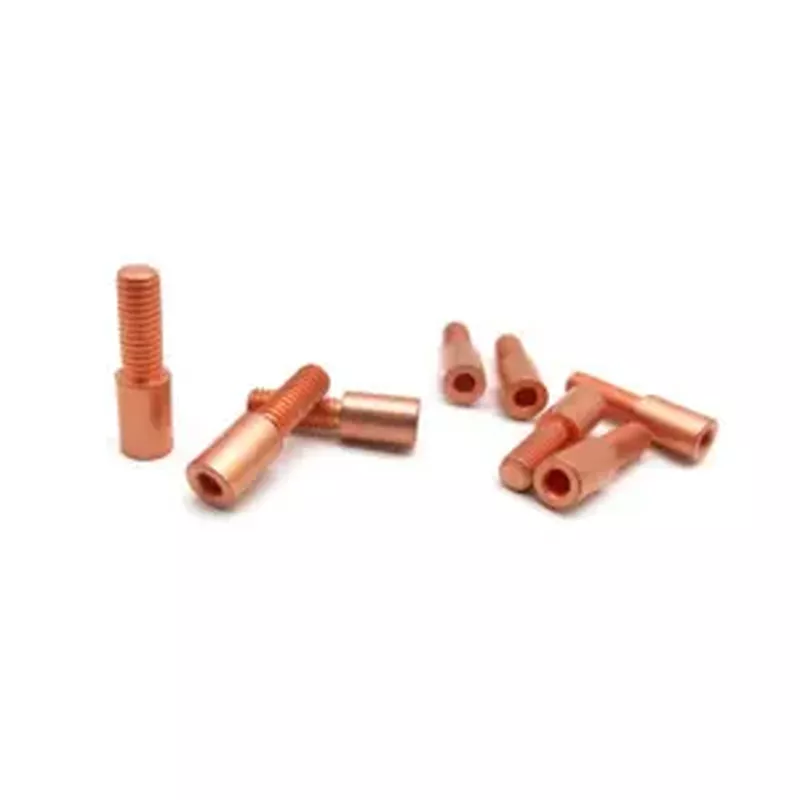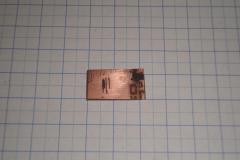 There are limitations to a rod-based process, but there is nothing else commercial out there that can do this at this price range. We view this as a great start and taking desktop EDM from 0 to 1.
There are limitations to a rod-based process, but there is nothing else commercial out there that can do this at this price range. We view this as a great start and taking desktop EDM from 0 to 1.
 @Thomas Shaddack I believe it would work with sintered brass or copper. I would love to try it
@Thomas Shaddack I believe it would work with sintered brass or copper. I would love to try it
 If it cuts 2mm steel and drills 40mm holes into steel I buy it. Is it possible?
If it cuts 2mm steel and drills 40mm holes into steel I buy it. Is it possible?
 There is a company Sapphire 3D that we have been talking to
There is a company Sapphire 3D that we have been talking to
![]() Virtual Foundry has the filaments. Or, if you want to skip the printing and go hand-moulding, metal clays or art clays, they come in copper/bronze/silver (and gold).
Virtual Foundry has the filaments. Or, if you want to skip the printing and go hand-moulding, metal clays or art clays, they come in copper/bronze/silver (and gold).
 I have not tried either of those cuts so I could not tell you one way or the other
I have not tried either of those cuts so I could not tell you one way or the other
 Do you think it is possible?
Do you think it is possible?
 Virtual foundry looked cool. I would like to check that out.
Virtual foundry looked cool. I would like to check that out.

![]() Would be a great thing for eg. gears. No need to stock all the billets, all the diameters we may need, and remove inly a small fraction of the material, wasting little.
Would be a great thing for eg. gears. No need to stock all the billets, all the diameters we may need, and remove inly a small fraction of the material, wasting little.
 I think for gears you'd ideally just be doing wire EDM on those, depending on size
I think for gears you'd ideally just be doing wire EDM on those, depending on size
![]() Nope, I assume. The percolation threshold for decent conductivity is hard to reach.
Nope, I assume. The percolation threshold for decent conductivity is hard to reach.
 Oh are you referring to the tool as a printed part?
Oh are you referring to the tool as a printed part?
 @Bharbour yes it is metal powder in a binder filament
@Bharbour yes it is metal powder in a binder filament
 @gedm-dev probably. You'd have to try it out
@gedm-dev probably. You'd have to try it out
 What if I told I have and found out that it just won't work?
What if I told I have and found out that it just won't work?
![]() You would likely have to fully process the part.
You would likely have to fully process the part.
 I would say to change parameters or tool geometry and to try again. EDM is a very complex process with a lot of ways to get things right
I would say to change parameters or tool geometry and to try again. EDM is a very complex process with a lot of ways to get things right
 I'm serious about it. Don't let people think they can mount an EDM unit to a printer and cut steel. I ripped apart GRBL to the core and compared it to Marlin. The core looks similar. And no. It won't work.
I'm serious about it. Don't let people think they can mount an EDM unit to a printer and cut steel. I ripped apart GRBL to the core and compared it to Marlin. The core looks similar. And no. It won't work.
 I generally recommend cutting aluminum with the Powercore. That's what we've had the most success with and what we've described in the Kickstarter. There is a lot of testing to be done on steel to find the limitations.
I generally recommend cutting aluminum with the Powercore. That's what we've had the most success with and what we've described in the Kickstarter. There is a lot of testing to be done on steel to find the limitations.
 If you were to use a wire tool you'd probably be doing great with steel on a 3D printer
If you were to use a wire tool you'd probably be doing great with steel on a 3D printer
![]() Are the limitations hard ("impossible") or soft (just s-l-o-w)?
Are the limitations hard ("impossible") or soft (just s-l-o-w)?
 a wire is ~8x smaller in diameter than the rods we use right now. So it will cut around 8x faster through the same material.
a wire is ~8x smaller in diameter than the rods we use right now. So it will cut around 8x faster through the same material.
 And really, there's a lot to be said for being able to mill parts on a desktop with a repurposed printer, even if it's "just" aluminum
And really, there's a lot to be said for being able to mill parts on a desktop with a repurposed printer, even if it's "just" aluminum
 I know. But everyone who have ever cutted hard steels and Aluminum know that Aluminum is like cutting a paper with a chansaw. This will work more or less good. But steel is something different.
I know. But everyone who have ever cutted hard steels and Aluminum know that Aluminum is like cutting a paper with a chansaw. This will work more or less good. But steel is something different.
 @Thomas Shaddack it is not impossible. The sparks erode steel. I do not have a lot of hard data on feeds and speeds yet but there are about to be 420+ people with the means to find out.
@Thomas Shaddack it is not impossible. The sparks erode steel. I do not have a lot of hard data on feeds and speeds yet but there are about to be 420+ people with the means to find out.
![]() Was thinking about a variant. A small-size high-accuracy EDM, for turning wasted pieces of carbide drill bits into taps or dies or single-point turning tools.
Was thinking about a variant. A small-size high-accuracy EDM, for turning wasted pieces of carbide drill bits into taps or dies or single-point turning tools.
![]() EDM is known to cut laterally any material that is conductive. This included hardened steels I am sure its just a matter of good process control.
EDM is known to cut laterally any material that is conductive. This included hardened steels I am sure its just a matter of good process control.
 Yes. Like I said, the sparks to remove material. You're probably going to be running ~3x slower in any steel stock when compared to aluminum of the same thickness.
Yes. Like I said, the sparks to remove material. You're probably going to be running ~3x slower in any steel stock when compared to aluminum of the same thickness.
 @Cooper What is the minimum feedrate that a normal Ender can provide?
@Cooper What is the minimum feedrate that a normal Ender can provide?
 The wear ratio is also worse with steel.
The wear ratio is also worse with steel.
 @Dan Maloney I agree. I am excited to try out some extruder and hotend parts from aluminum when I get the free time to do so
@Dan Maloney I agree. I am excited to try out some extruder and hotend parts from aluminum when I get the free time to do so
![]() Nozzle drilling.
Nozzle drilling.
 DIY high flow nozzles 😍
DIY high flow nozzles 😍
![]() Braze a little piece of tungsten carbide into the standard brazz nozzle tip. EDM-drill.
Braze a little piece of tungsten carbide into the standard brazz nozzle tip. EDM-drill.
 You could also play with orifice geometry
You could also play with orifice geometry
 @gedm-dev idk off the top of my head. Somewhere around 15mm/min is my guess
@gedm-dev idk off the top of my head. Somewhere around 15mm/min is my guess
 you could ask creality
you could ask creality
 That is way to fast for HSS.
That is way to fast for HSS.
 yes you'd definitely want to do a wire EDM tool for that.
yes you'd definitely want to do a wire EDM tool for that.
 at least thick stuff
at least thick stuff
 If you remember the GEDM video. HSS drilled at about 1mm/min at 30v. A bit faster at 60.
If you remember the GEDM video. HSS drilled at about 1mm/min at 30v. A bit faster at 60.
 Higher voltages would help you. I've spoken to Ben Fleming about this and he recommends upwards of 120v for steels
Higher voltages would help you. I've spoken to Ben Fleming about this and he recommends upwards of 120v for steels
![]() With how big electrode?
With how big electrode?
 I think Ben uses die plunging for his EDM machines, so fairly large
I think Ben uses die plunging for his EDM machines, so fairly large
 but he's also pulsing around 200KHz iirc
but he's also pulsing around 200KHz iirc
 The size was from 1 to 3mm in the video. That didn't affected the speed much. Enough power to compensate the size.
The size was from 1 to 3mm in the video. That didn't affected the speed much. Enough power to compensate the size.
 Seems like something you could fix with a couple of pulleys and belts. Yeah, it's a hardware change, but if you really want to cut HSS on an Ender, seems like solid investment
Seems like something you could fix with a couple of pulleys and belts. Yeah, it's a hardware change, but if you really want to cut HSS on an Ender, seems like solid investment
 That wouldn't make it a stock ender. Or?
That wouldn't make it a stock ender. Or?
 @Dan Maloney that's very true! I was just thinking the same thing. Overall John and I believe that wire will be the way to go in the future
@Dan Maloney that's very true! I was just thinking the same thing. Overall John and I believe that wire will be the way to go in the future
 @gedm-dev think of this as the early days of RepRap. Did the extruder design stay the same over time? Perfect is not important right now. It is making solid progress and continuing to do so consistently.
@gedm-dev think of this as the early days of RepRap. Did the extruder design stay the same over time? Perfect is not important right now. It is making solid progress and continuing to do so consistently.
![]() Or maybe use solenoid for the z-axis, for the slow sinking. Feedback directly to the spark. Once it moves off the limits, do a move by the machine's steppers. Assuming we go primarily top-down.
Or maybe use solenoid for the z-axis, for the slow sinking. Feedback directly to the spark. Once it moves off the limits, do a move by the machine's steppers. Assuming we go primarily top-down.
 There is going to be a lot of learning about desktop EDM for everyone in the next few years.
There is going to be a lot of learning about desktop EDM for everyone in the next few years.
 I hope so -- the idea of home-gamer EDM is very exciting to me
I hope so -- the idea of home-gamer EDM is very exciting to me
 I'm just concerned that you made the people believe they can cut metal if they buy your product. But the facts clearly say that this is just not true.
I'm just concerned that you made the people believe they can cut metal if they buy your product. But the facts clearly say that this is just not true.
 Simplest might just be to gear the axes like Dan said. That would be mostly printable for people
Simplest might just be to gear the axes like Dan said. That would be mostly printable for people
![]() For me as well. Circling around it for years and didn't start biting yet.
For me as well. Circling around it for years and didn't start biting yet.
 Yeah it's really exciting! I just wish I had more time to play with EDM instead of running things right now.
Yeah it's really exciting! I just wish I had more time to play with EDM instead of running things right now.
 OK @gedm-dev, I think we get your point, thanks.
OK @gedm-dev, I think we get your point, thanks.
 @cooper That's again just a fix that you haven't tested for a problem you say doesn't exist. Confusing.
@cooper That's again just a fix that you haven't tested for a problem you say doesn't exist. Confusing.
![]() How much EMI does the process cause? Will it tend to cause trouble with the controllers?
How much EMI does the process cause? Will it tend to cause trouble with the controllers?
 We have not had significant errors due to EMI yet. We have had the PSU tested at an FCC facility, but that doesn't include the electrodes.
We have not had significant errors due to EMI yet. We have had the PSU tested at an FCC facility, but that doesn't include the electrodes.
 As an informal test, we are able to steam HD video on a phone right next to the spark gap during cuts.
As an informal test, we are able to steam HD video on a phone right next to the spark gap during cuts.
 The enclosure is aluminum and is well grounded, so that helps with PSU noise. I certainly wouldn't put an antenna on the output though
The enclosure is aluminum and is well grounded, so that helps with PSU noise. I certainly wouldn't put an antenna on the output though
![]() Phones don't have unshielded wiring of considerable length all around.
Phones don't have unshielded wiring of considerable length all around.
 Yes that's true
Yes that's true
![]() I don't think the PSU itself will be a problem. The spark and the wires to the spark, more likely.
I don't think the PSU itself will be a problem. The spark and the wires to the spark, more likely.
 Yes definitely. It is an inherently EMI heavy process
Yes definitely. It is an inherently EMI heavy process
![]() Thought. Software-defined radio for contactless process monitoring.
Thought. Software-defined radio for contactless process monitoring.
 Thomas, we have considered the exact same thing!
Thomas, we have considered the exact same thing!
![]() Heee!
Heee!
 There's definitely potential there
There's definitely potential there


 Here's something else neat you can do with EDM.
Here's something else neat you can do with EDM.
![]() I saw somewhere a sink-edm design, very rudimentary, that used a capacitor-resistor bank and regulated the electrode sink rate by voltage on the cap. Above threshold, send steps to stepper. Below second threshold, send steps upwards.
I saw somewhere a sink-edm design, very rudimentary, that used a capacitor-resistor bank and regulated the electrode sink rate by voltage on the cap. Above threshold, send steps to stepper. Below second threshold, send steps upwards.
![]() What's that?
What's that?
 Ancient tech.
Ancient tech.
 drill holes and then tap them with an orbital path afterwards
drill holes and then tap them with an orbital path afterwards
 Those almost look like MIG tips
Those almost look like MIG tips
 If you had a good way to switch out tools and keep position you could drill holes and thread afterward with EDM
If you had a good way to switch out tools and keep position you could drill holes and thread afterward with EDM
![]() Thought. Rotating copper disc as an EDM equivalent of a grinding wheel. For sharpening carbide tools.
Thought. Rotating copper disc as an EDM equivalent of a grinding wheel. For sharpening carbide tools.
 How are you doing the threading?
How are you doing the threading?
 @Thomas Shaddack that's a cool idea. I think you might be better off just getting new carbide though.
@Thomas Shaddack that's a cool idea. I think you might be better off just getting new carbide though.
 The finish from EDM will not mimic factory
The finish from EDM will not mimic factory
 @Dan Maloney you would EDM a hole first and then switch to the threading tool. The threading tool would orbit within the already drilled hole.
@Dan Maloney you would EDM a hole first and then switch to the threading tool. The threading tool would orbit within the already drilled hole.
 Have you done a sinker job like that?
Have you done a sinker job like that?
![]() True. But think resource-constrained areas (Mars base, some hole in the middle of Africa...), or logistical pressures (we can't wait for delivery).
True. But think resource-constrained areas (Mars base, some hole in the middle of Africa...), or logistical pressures (we can't wait for delivery).
 We have not tried tapping yet though
We have not tried tapping yet though
 It's an idea. I have seen people cut carbide on desktop with EDM before
It's an idea. I have seen people cut carbide on desktop with EDM before


 this was someone I've been speaking to.
this was someone I've been speaking to.
 Doesn't surprises me. it may not work very well. Aluminum and water in combination with a none moving sinker electrode = trouble. High material removal rate may help. But all in all Alu can be pain in combination with water.
Doesn't surprises me. it may not work very well. Aluminum and water in combination with a none moving sinker electrode = trouble. High material removal rate may help. But all in all Alu can be pain in combination with water.
![]() I remember seeing spark-threading on the TV back in the 1980s. They were just rotating a threaded electrode at the same time as they lowered it. I am not sure threadmilling had been invented then, or maybe its just that the EDM threading inventor hadn't heard of it.
I remember seeing spark-threading on the TV back in the 1980s. They were just rotating a threaded electrode at the same time as they lowered it. I am not sure threadmilling had been invented then, or maybe its just that the EDM threading inventor hadn't heard of it.
 I'm out. Keep up the good.... Hmm. Scam. :D
I'm out. Keep up the good.... Hmm. Scam. :D
 If you're doing a sinker op you're going to want oil anyway. The threading op isn't really sinker though
If you're doing a sinker op you're going to want oil anyway. The threading op isn't really sinker though
 It is an orbital path around an already drilled hole. Water should be fine
It is an orbital path around an already drilled hole. Water should be fine
 @Andy Pugh that is another way to do it.
@Andy Pugh that is another way to do it.
![]() Some photos of my circuitboard experiments. Under a big drop of kitchen-class vegetable oil under stereomicroscope. Hint, it WILL aerosolize and cleaning the lens is a pain.
Some photos of my circuitboard experiments. Under a big drop of kitchen-class vegetable oil under stereomicroscope. Hint, it WILL aerosolize and cleaning the lens is a pain.
![]()
https://www.improwis.com/projects/method_EDMdischargeCircuitboardEtching/
Method under development - EDM machining of circuitboards
Electrical discharge machining of circuitboards
 If you use a bit more distilled water it will splash far less. Like keep the tool submerged an inch or so to prevent splash
If you use a bit more distilled water it will splash far less. Like keep the tool submerged an inch or so to prevent splash
 there is little enough matl to remove that water will be fine.
there is little enough matl to remove that water will be fine.
![]() Yup. It was a proof of concept if it can work at all.
Yup. It was a proof of concept if it can work at all.
 What sort of PSU did you use?
What sort of PSU did you use?
![]() Just a lab power supply, using resistor to limit current to a capacitor, and a handheld wire. Voltage in the ballpark of 12v, cap if I remember some tens to hundreds microfarads?
Just a lab power supply, using resistor to limit current to a capacitor, and a handheld wire. Voltage in the ballpark of 12v, cap if I remember some tens to hundreds microfarads?
 I think we're around 52uF rn on the Powercore
I think we're around 52uF rn on the Powercore
![]() I think the crucial thing is the spark energy delivered to the metal itself. Not enough and you just dent the copper. Too much and you get a crater with ejecta around.
I think the crucial thing is the spark energy delivered to the metal itself. Not enough and you just dent the copper. Too much and you get a crater with ejecta around.
![]() The 35um of copper isn't that much to eat through, can be done on a single spark.
The 35um of copper isn't that much to eat through, can be done on a single spark.
 Is overdoing it a problem? I would like to try this on the Powercore
Is overdoing it a problem? I would like to try this on the Powercore
 oil might be perfect for PCBs. Slow and steady to make those.
oil might be perfect for PCBs. Slow and steady to make those.
![]() May be if you want extra-high resolution. Certainly worth trying. You may scorch the resin below, will see.
May be if you want extra-high resolution. Certainly worth trying. You may scorch the resin below, will see.
 Have you calculated your sparks per second?
Have you calculated your sparks per second?
 Dan Maloney
Dan Maloney
Discussions
Become a Hackaday.io Member
Create an account to leave a comment. Already have an account? Log In.